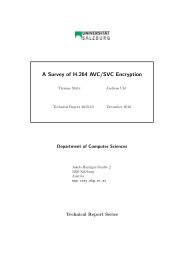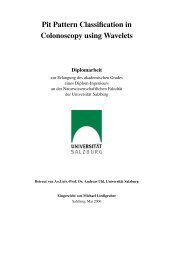Single-sensor hand and footprint-based multimodal biometric ...
Single-sensor hand and footprint-based multimodal biometric ...
Single-sensor hand and footprint-based multimodal biometric ...
Create successful ePaper yourself
Turn your PDF publications into a flip-book with our unique Google optimized e-Paper software.
2.6 Multimodal <strong>biometric</strong> systems<br />
2.6 Multimodal <strong>biometric</strong> systems<br />
In its most dem<strong>and</strong>ing forms of application, namely screening (i.e. matching against a<br />
database of wanted persons, e.g. terrorists) <strong>and</strong> large scale identification (i.e. identification<br />
from a large number of possible subjects, e.g. criminal investigation), <strong>biometric</strong>s is faced<br />
with the problem of having to guarantee extremely low error rates. Jain et al. [11]<br />
quantified accuracy requirements for matchers as less than 1 · 10 −3 % FNMR for large scale<br />
identification from 1 million members <strong>and</strong> less than 1% FNMR for screening from a watch<br />
list of 500 members respectively at 1·10 −4 % FMR. The main reason for these requirements<br />
is the fact that in identification mode the FMR is approximately linear dependent on the<br />
number of enroled members in the system database [1]. These rates, however, can hardly<br />
be accomplished in unimodal systems <strong>and</strong> it is even hard to bridge the gap between current<br />
matchers <strong>and</strong> performance requirements in <strong>multimodal</strong> <strong>biometric</strong> systems. Design issues<br />
of multi<strong>biometric</strong> systems (as introduced in the last 10 years) are discussed in [32, 21, 33].<br />
Multi<strong>biometric</strong> techniques were introduced by multi-classifier literature (multi<strong>biometric</strong><br />
systems may be seen as multi-classifiers over a two-class classification problem [21]) <strong>and</strong><br />
have gained enormous popularity in the last decade due to [33]:<br />
• their ability to improve matching accuracy;<br />
• higher flexibility in case of failure to acquire single <strong>biometric</strong>s <strong>and</strong>;<br />
• more difficult <strong>biometric</strong> system attacks (all individual <strong>biometric</strong>s have to be attacked<br />
at the same time).<br />
Most multi<strong>biometric</strong> systems today incorporate fusion in multiple unit <strong>and</strong> multiple <strong>biometric</strong>s<br />
scenarios (see [14]), since these combine completely independent pieces of information<br />
<strong>and</strong> thus result in higher matching improvements [21]. The systems introduced<br />
in this work are single-<strong>sensor</strong> multi<strong>biometric</strong> systems <strong>and</strong> are thus, in the sense of [14],<br />
“only” multiple matcher scenarios (<strong>and</strong> therefore considered to combine strongly correlated<br />
measurements in the opinion of [21]). However, features are expected to be largely<br />
independent, when extracted at different resolutions, such as e.g. the global (singular<br />
points), local (minutiae) <strong>and</strong> very-fine (sweat pores) fingerprint levels, <strong>and</strong> from different<br />
parts of the input image. Using the latter, one can see that multiple unit scenarios in<br />
[14] may be considered as subsets of multiple matcher scenarios when the input covers<br />
multiple units <strong>and</strong> is constrained in size for single matchers. This is, in fact, the case in<br />
the proposed system, when fingerprint regions of single fingers are extracted as part of the<br />
preprocessing step <strong>and</strong> the results of individual units are merged.<br />
Multimodal <strong>biometric</strong> systems employ fusion strategies to consolidate information. According<br />
to [32] fusion may be incorporated:<br />
• at the feature extraction level consolidating multiple independent <strong>biometric</strong><br />
feature vectors via concatenation into one single high-dimensional template;<br />
• at the matching score level combining the individual scores of multiple matchers<br />
into one score indicating the similarity between feature vector <strong>and</strong> reference template;<br />
19








